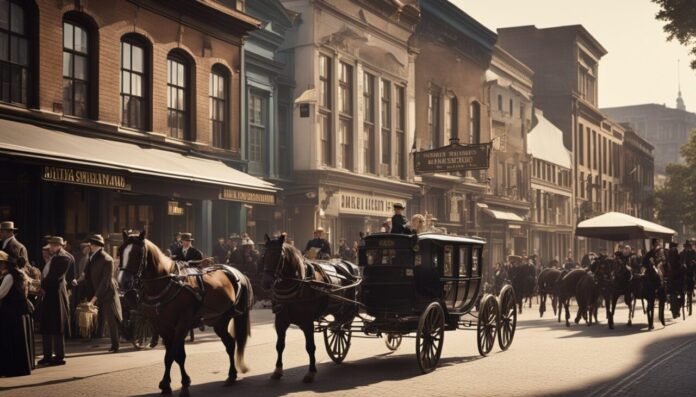
Life in the 1800s was massively different from what we experience today. The 19th century was a time of big change and turmoil, marked by substantial advancements, inventions, political revolutions, and social reforms.
One of the most significant changes in the 1800s was the Industrial Revolution (1760-1840). The development of new machinery and technologies led to the mass production of goods and a shift from manual labor to machine-based manufacturing.
This change had a big impact on society, leading to the growth of urban centers and the rise of the middle class.
However, despite these advancements, people in the 1800s led very challenging lives. Except the rich people of course.
Many other people lived in poverty and worked long hours in dangerous conditions. Women and children were often exploited in factories, and there were few laws in place to protect workers’ rights.
And so, join us in this deep exploration of the world 200 years ago.
In this article, we will describe all segments of life in the 1800s, from employment, love life, housing, transportation, daily habits, and much more.
Related:
Daily Life and Social Structure
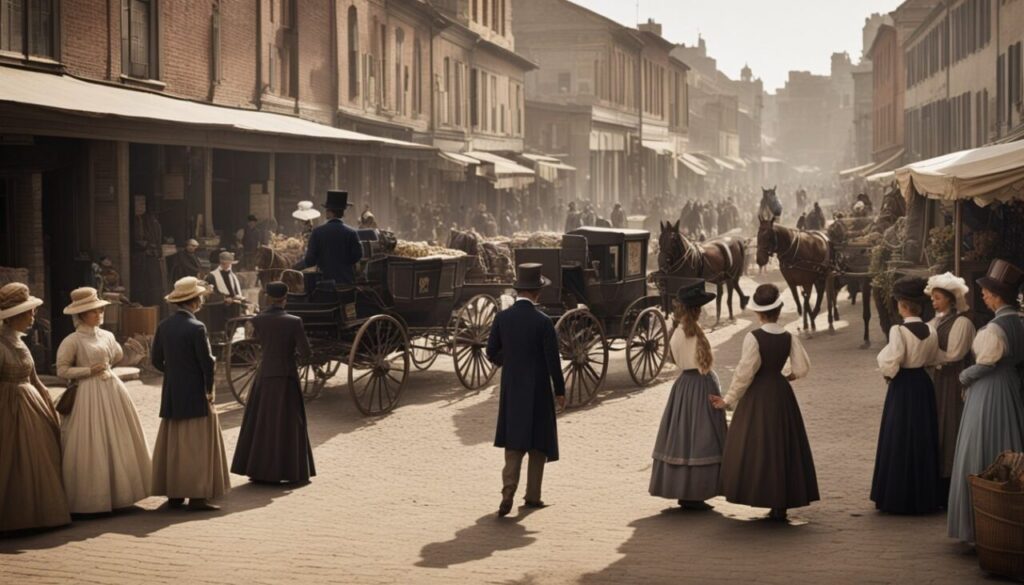
Family Life
In the 1800s, family life was centered around the patriarchal figure, who was usually the father or the eldest male in the family. The father was responsible for providing for his family and making important decisions.
Women were expected to be obedient to their husbands and take care of the household and children. Children were expected to respect and obey their parents.
Families typically had many children, and it was common for multiple generations to live together under one roof.
Interesting fact: In the 1800s, it was common for families to have a "family bed" where everyone slept together in one large bed (communal sleeping).
Gender Roles and Expectations
Gender roles in the 1800s were very traditional. Men were expected to work outside of the home and provide for their families, while women were expected to stay at home and take care of the household and children.
Women had very few opportunities for education or employment outside of the home. They were also expected to dress modestly and behave in a ladylike manner at all times.
Intriguing fact: Women in the 1800s were not allowed to vote or own property in many parts of the world. New Zealand was the first country to give voting rights to women. This happened in 1893. In Europe, the Swiss canton of Appenzell Innerrhoden (AI) was the last jurisdiction to grant women the right to vote, doing so in 1991.
Class Distinctions
Social class was very important in the 1800s. The upper class consisted of wealthy landowners and aristocrats, while the lower class consisted of laborers and farmers.
There was very little social mobility, and it was difficult for people to move up in social class.
Also, the middle class emerged during this time, consisting of merchants, professionals, and other non-aristocratic individuals who were able to accumulate some wealth through business or trade.
Population in 1800s

The population in the 1800s saw a significant increase due to various factors such as the Industrial Revolution, improved medical care, and better living conditions.
For example, the population of the United States in 1800 was approximately 5.3 million, and by 1900, it had grown to over 76 million.
However, the growth of the population was not evenly distributed across the country.
The majority of the population growth occurred in urban areas due to the availability of jobs in factories and industries.
The rural population, on the other hand, grew at a slower rate due to the lack of job opportunities and poor living conditions.
The increase in population was also caused due to immigration. Many people migrated to the United States from Europe and Asia in search of better opportunities.
Interesting fact: The population of New York City in 1800 was only 60,515, but by 1900, it had grown to over 3.4 million, making it the largest city in the United States and 2nd in the world. At the beginning of the century, Beijing was the biggest city with a population of 1.1 million. By the end of the century, London was the biggest city with a population of 6.48 million.
Transportation in 1800s

In the 1800’s there were no cars or airplanes to travel long distances quickly. Instead, people relied on horses, carriages, and boats to get around.
Horses were the primary mode of transportation for most people. They were used for everything from plowing fields to pulling carriages.
Boats were also an essential mode of transportation in the 1800s. Steamboats were invented in the early 1800s, which made it even easier.
The first railroads were built in the 1820s, and they quickly became a popular mode of transportation.
Railroads made it possible to travel long distances quickly and efficiently. By the end of the 1800s, there were over 200,000 miles of railroad tracks in the United States.
Interesting fact: The First Transcontinental Railroad in the United States was completed in 1869. It connected the east and west coasts of the country.
Love Life in 1800s
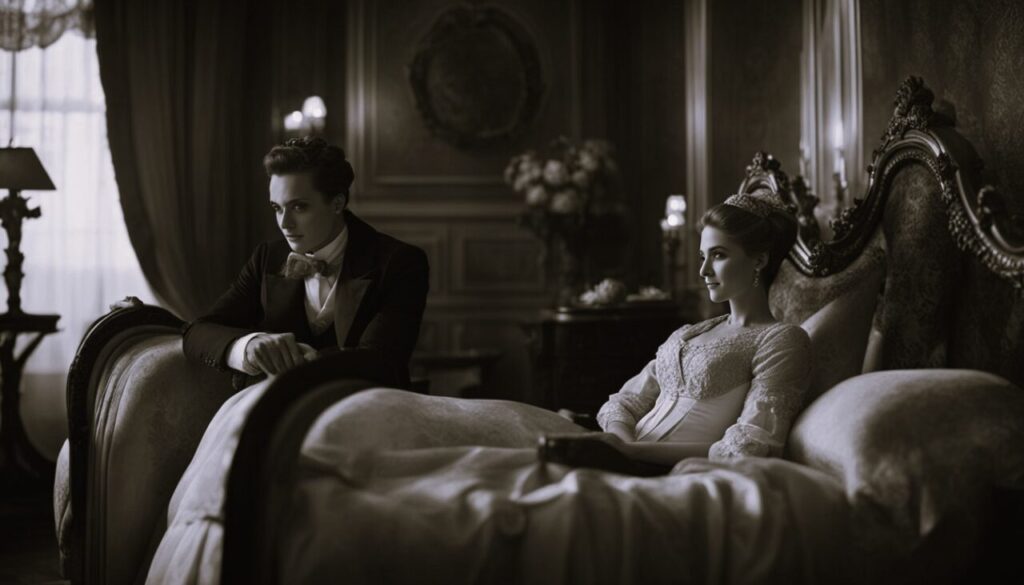
During the 1800s, love and marriage were viewed much differently than they are today.
Love was not considered the most important factor in a marriage. Instead, practical considerations such as wealth, social status, and family connections were given more weight.
Women were expected to be faithful and modest, and dating (if that could be called dating) was strictly monitored by parents and chaperones.
Romantic gestures such as holding hands and kissing were considered inappropriate in public. Instead, couples would exchange letters and small gifts as a way of showing affection.
See also: When Did Humans Start Kissing?
Marriage was seen as a duty rather than a choice, and divorce was rare and socially unacceptable. Women had few legal rights and were often financially dependent on their husbands. Infidelity was not tolerated, and women who were caught cheating could face severe consequences.
Interesting fact: In the early 1800s, it was common for couples to have a "bundling board" in their homes. This was a board that was placed between the couple in bed to prevent any physical contact while they slept.
Information Exchange in 1800s
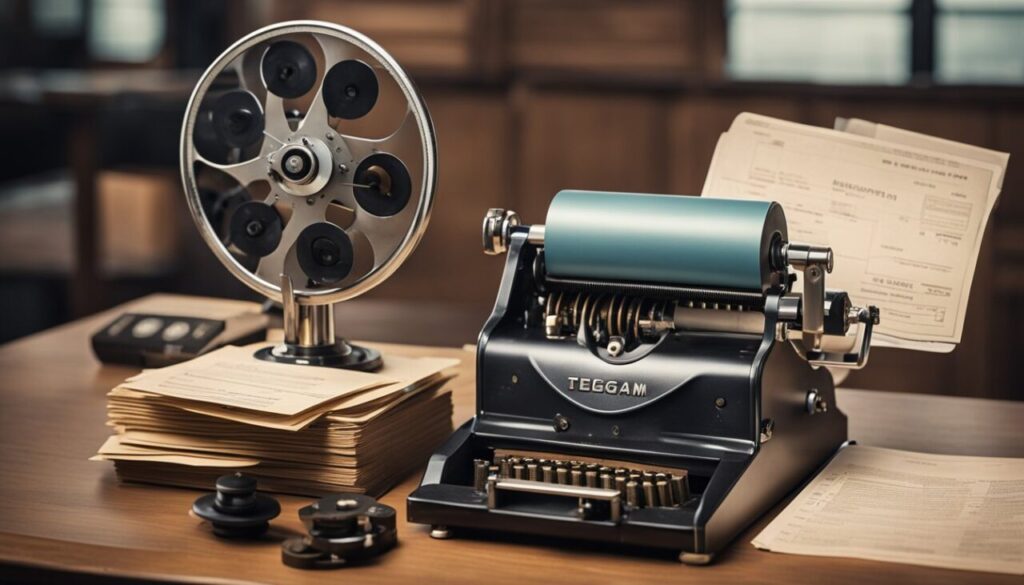
In the 1800s, information exchange was limited to physical mediums such as newspapers, letters, and telegraphs. People relied on newspapers to get the latest news and updates from around the world.
The newspapers were printed on large sheets of paper and distributed to subscribers. The cost of a subscription rather was high, and only the wealthy could afford it.
Letters were another popular medium of communication. People used to write letters to their family and friends living in different parts of the world. The letters were sent through the postal service, which was slow and expensive. It took weeks or even months for a letter to reach its destination.
Telegraphs were a significant advancement in information exchange during the 1800s.
Samuel Morse invented the telegraph in 1837, which allowed people to send messages over long distances quickly. The telegraph system used Morse code, a series of dots and dashes, to send messages. Telegraph offices were set up in major cities, and people could send and receive messages from these offices.
Interesting fact: In 1866, the first successful transatlantic telegraph cable was laid, connecting Europe and North America. This allowed people to send messages across the Atlantic in a matter of minutes.
Employment and Economy in 1800s

Agricultural Practices
In the 1800s, agriculture was the primary source of employment for a majority of people in the United States and worldwide.
Farmers relied on manual labor and basic tools to cultivate crops and raise livestock. The most common crops grown during this time were corn, wheat, and cotton.
Farmers also raised livestock such as cattle, pigs, and chickens. The agricultural practices in the 1800s were largely subsistence-based, with farmers growing enough food to feed their families and sell any excess at local markets.
Interesting fact: In the 1800s, the invention of the steel plow by John Deere revolutionized farming and made it easier for farmers to cultivate their land.
Industrial Work
As the Industrial Revolution gained momentum, factories began to emerge across the country.
The textile industry was one of the first industries to be mechanized, and many people found employment in textile mills.
However, the working conditions in factories were very poor, with long hours and low wages. Children were also often employed in factories, working alongside adults.
Interesting fact: In the 1800s, the Lowell Mills in Massachusetts were one of the largest textile mills in the world, employing thousands of workers.
Education and Literacy in 19th Century

Schooling and Universities
In the 1800s, education was not mandatory, and many children did not attend school. Wealthy families hired tutors to teach their children, while poor families had to rely on charity schools or send their children to work.
See also: History of Education System!
In the United States, public schools began to emerge in the mid-1800s, but they were often poorly funded and lacked qualified teachers.
In Europe, universities were typically reserved for the wealthy and privileged, and admission was based on social status rather than skill and knowledge.
Interesting fact: The first public high school in the United States, Boston Latin School, was founded in 1635. At first, the school only admitted boys. This changed in the 19th century when they allowed also girls to attend school.
Literacy Rates
Literacy rates varied widely in the 1800s depending on location and social class. In Europe, literacy was generally higher among the upper classes, while in the United States, literacy rates were higher in the North than in the South. Women and minorities were often excluded from education, which contributed to lower literacy rates.
Interesting fact: In 1840, the literacy rate in the United States was around 78 percent.
Politics and Governance in 19th Century
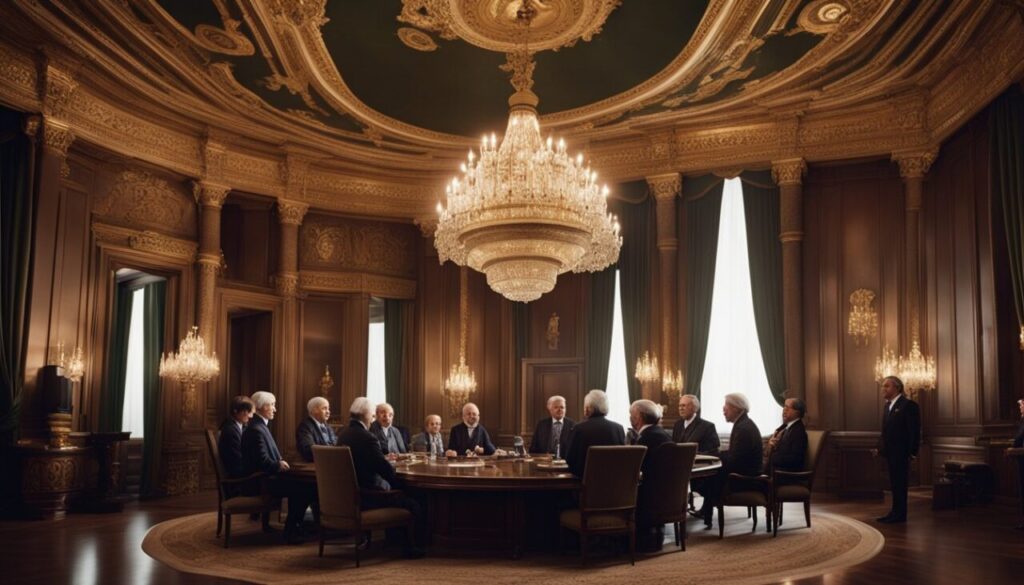
Political Systems
The 1800s were times of big political changes around the world.
Many countries were transitioning from absolute monarchies to constitutional monarchies or republics.
In Europe, the Napoleonic Wars had a significant political impact, leading to the rise of nationalism and the formation of new states.
In the United States, the country was still relatively new, and the political system was heavily influenced by the ideas of the founding fathers.
In many countries, only a small percentage of the population had the right to vote. In the United States, for example, only white male property owners could vote.
Women, African Americans, and Native Americans were excluded from the political process. However, there were movements for political reform, and many countries gradually expanded the right to vote.
Interesting fact: The first modern constitution in Europe was adopted by Norway in 1814.
Law and Order
In the 1800s, crime rates were rather high, and there were few effective ways to deal with criminals. Prisons were overcrowded and often inhumane. Punishments were regularly very severe and included public execution, transportation to colonies, and hard labor.
See also: World Without Laws and Rules!
In many countries, the legal system was based on the Napoleonic Code, which emphasized equality before the law and the rights of the individual. However, there were still many injustices, particularly towards marginalized groups such as women and minorities.
Interesting fact: In 1829, the Metropolitan Police Force was established in London, England, which was the first modern police force in the world.
Culture and Entertainment in 19th Century
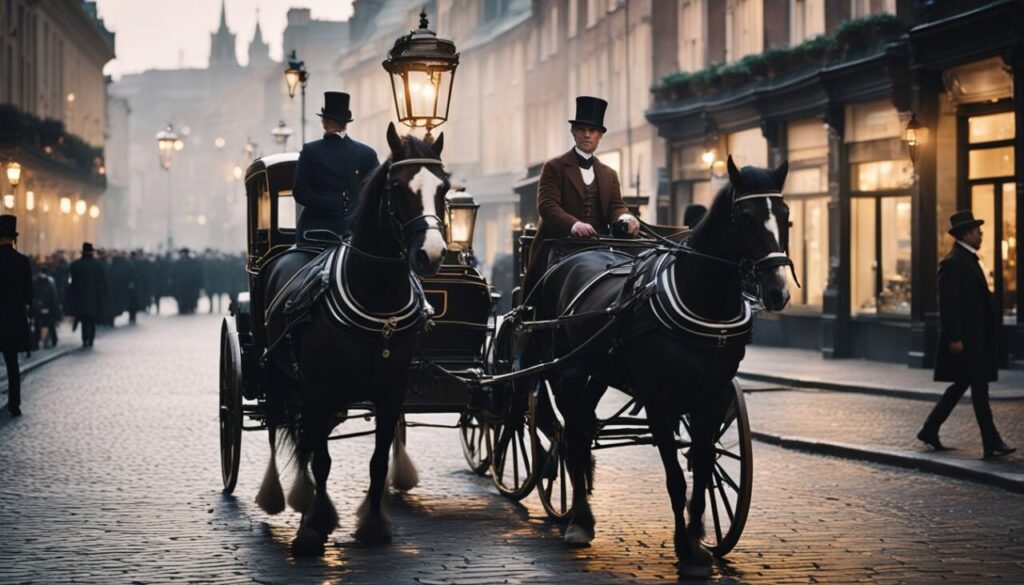
Arts and Literature
In the 1800s, arts and literature were highly valued and considered a sign of refinement and sophistication.
Many artists and writers gained recognition during this time, including William Wordsworth, Jane Austen, John Keats, and Edgar Allan Poe. Literature was primarily focused on romanticism, realism, and gothic fiction.
Artists during this time also experimented with new techniques and styles, such as impressionism and post-impressionism.
Many famous works of art were created during this time, including Vincent van Gogh’s “Starry Night” and Claude Monet’s “Water Lilies.”
Interesting fact: The first public art museum, the Louvre, opened in Paris in 1793.
Music
Music was an important part of the culture in the 1800s, and many famous composers, such as Ludwig van Beethoven, created some of their most famous works during this time.
Opera was also very popular, with composers such as Giuseppe Verdi and Richard Wagner creating some of the most famous operas of all time.
Sports and Leisure
In the 19th century, sports and leisure activities were primarily enjoyed by the upper classes. Hunting, fishing, and horseback riding were popular activities for the wealthy, while middle-class people liked activities such as bowling and billiards.
The first modern Olympic Games were held in Athens, Greece in 1896, and sports such as tennis and golf gained popularity during this time.
Interesting fact: The first baseball game was played in 1846 in Hoboken, New Jersey.
Religion and Beliefs in 1800s

Dominant Religions
In the 1800s, Christianity was the dominant religion in most of the Western world (as it is now). Other religions, such as Judaism and Islam, were also present in some regions, but they had a much smaller following.
Interesting fact: The Second Great Awakening, a religious revival that swept through the United States in the early 1800s, led to a significant increase in the number of Protestant denominations and the overall religiosity of the country.
See also: What If Religion Never Existed?
Religious Practices
Religious practices varied widely depending on the religion and the region. Christians typically attended church services on Sundays and observed religious holidays such as Christmas and Easter. Some Christians also participated in individual or group prayer, Bible study, and other religious activities outside of church. Jews observed the Sabbath and other religious holidays, and Muslims prayed five times a day.
Interesting fact: In some parts of Europe, it was illegal to practice any religion other than the dominant one, and people caught doing so could face severe punishment.
Military and Warfare in 19th Century

Military Technology
The 1800s saw significant advancements in military technology. The most notable of these was the introduction of rifled muskets (muzzle-loaded long guns), which had a much longer range and greater accuracy than the smoothbore muskets of the past.
Additionally, the era saw the development of artillery that was more accurate and had a longer range. The introduction of steam power also led to the creation of steam-powered warships that could travel faster and carry more armaments than their predecessors.
Interesting fact: The name of soldier Musketeer comes from having rifled muskets.
Warfare Tactics
The tactics used in warfare during the 1800s were heavily influenced by the Napoleonic Wars.
Armies would often line up in rows and fire at each other until one side was victorious. However, as the century progressed, tactics began to change. The introduction of rifled muskets made it more difficult to charge enemy lines, and armies began to use cover and concealment to protect themselves.
Interesting fact: The Battle of Gettysburg during the American Civil War saw the use of tactics that were ahead of their time, including the use of trenches and fortifications.
Conscription and Service
During the 1800s, conscription (draft) became a common practice in many countries. This meant that young men were required to serve in the military for a set period of time.
In some cases, this service could last for several years. Military service was often seen as a duty to one’s country, and those who avoided conscription were often looked down upon.
Health and Medicine in 1800s

Common Diseases
The 1800s were a time of great medical progress, but infectious diseases were still widespread.
Common illnesses included tuberculosis, cholera, typhoid fever, and smallpox. These diseases were often spread through poor sanitation and hygiene practices.
Doctors had limited knowledge of germ theory and often prescribed ineffective treatments such as bleeding, purging, and leeching. Despite this, some doctors did have success with vaccination, particularly for smallpox.
Interesting fact: In 1854, John Snow traced the source of a cholera outbreak in London to a contaminated water pump, helping to establish the importance of clean water in preventing disease.
Healthcare Practices
Medical care in the 1800s was often inaccessible and expensive. Many people relied on home remedies and folk medicine for minor ailments.
For more serious conditions, patients would seek out doctors or visit a hospital. However, hospitals were often overcrowded and unsanitary, leading to high mortality rates.
Nursing was also a new profession in the 1800s, with Florence Nightingale being a pioneer in the field. She established the first professional nursing school and emphasized the importance of cleanliness and hygiene in patient care.
Interesting fact: In 1846, the first successful use of anesthesia during surgery was performed by dentist William Morton.
Life Expectancy
Life expectancy in the 1800s was much lower than it is today, with an average lifespan of around 40 years. However, this average lifespan of 40 years was mostly calculated like that due to high infant mortality rates. Namely, in 1800, the child mortality rate in the United States, for children under the age of five, stood at 462.9 deaths per thousand births. This means that out of every thousand babies born in 1800, over 46 percent did not survive to reach their fifth birthday.
Poor living conditions, malnutrition, and lack of access to medical care all contributed to the high mortality rates. However, improvements in sanitation and hygiene practices, as well as advances in medical knowledge, gradually led to longer lifespans over time.
Interesting fact: In 1875, the Public Health Act was passed in Britain, which established standards for public health and sanitation, leading to significant improvements in health and hygiene.
Fashion and Clothing in 1800s
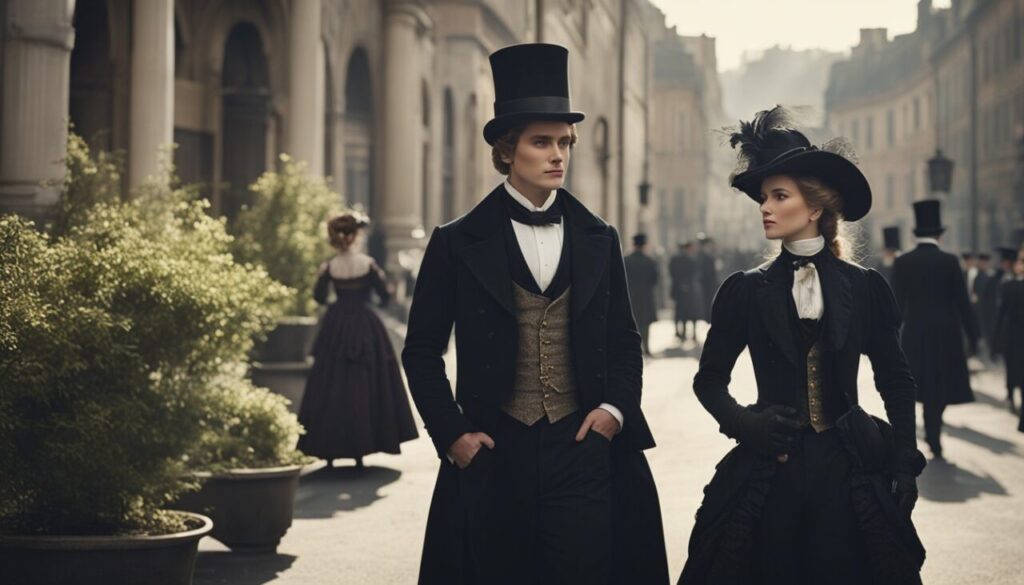
Everyday Clothing
In the 1800s, everyday clothing for men and women was quite different from what we wear today.
Men usually wore a shirt, vest, trousers, and a coat. Women wore long dresses with long sleeves and high collars. The dresses were usually made of cotton or wool. Most of the time, both men and women wore hats when they went outside.
Special Occasion Wear
Special occasions called for more formal attire. Men wore suits with tailcoats, waistcoats, and trousers. Women wore fancy dresses made of silk or satin, often with lace or embroidery.
Interesting fact: In the mid-1800s, it was fashionable for women to wear crinolines (hoopskirts), which were large hoop skirts that made their dresses stand out.
Architecture and Housing in 19th Century
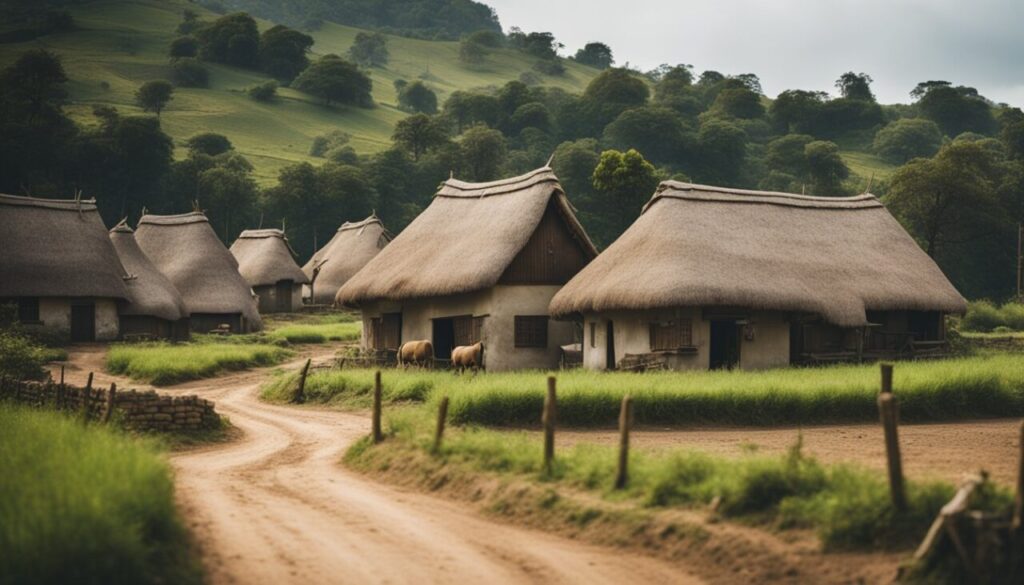
Urban Design
In the 1800s, cities were growing at record rates, and urban design became an important aspect of city planning.
Most cities were characterized by narrow streets, crowded buildings, and poor sanitation. Architects and city planners began implementing new designs that would improve living conditions.
The most notable design was the grid system, which involved dividing cities into square blocks with streets running parallel and perpendicular to one another.
Interesting fact: The grid system was first introduced in Philadelphia in 1682 by William Penn, but it wasn't until the 19th century that it became widely adopted.
Rural Housing
In the 1800s, the majority of people still lived in rural areas. Most rural homes were simple, one-room cabins made of wood or sod (earthy material). The houses were often heated by wood-burning stoves, and there was no indoor plumbing. Families typically slept in one or two rooms, with children sharing beds or sleeping on the floor.
Influential Architectural Styles
The 1800s saw the rise of several influential architectural styles, including Gothic Revival, Greek Revival, and Victorian. Gothic Revival was characterized by pointed arches, intricate tracery, and ornate decoration. Greek Revival was inspired by ancient Greek architecture and featured columns, pediments, and symmetrical design. Victorian architecture was known for its ornate decoration, asymmetrical design, and eclectic mix of styles.
Interesting fact: The Eiffel Tower, a symbol of French engineering and design, was completed in 1889 and was the tallest structure in the world until 1930.
Food and Cuisine in 19th Century
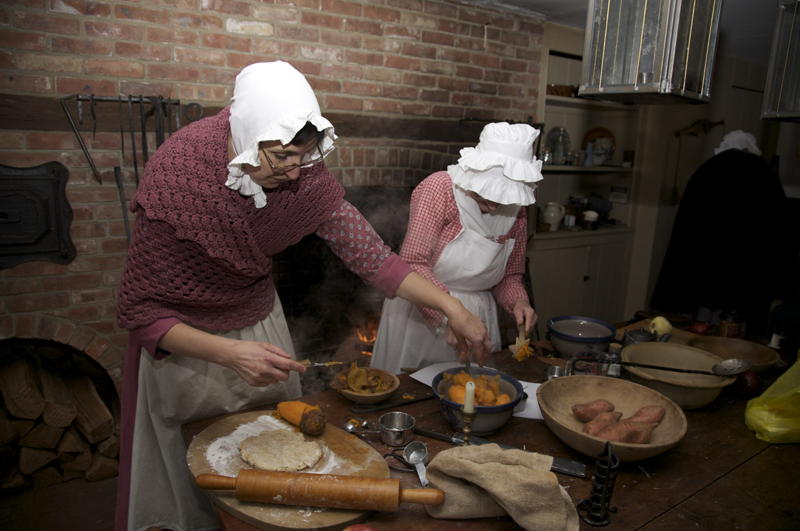
In the 1800s, the diet of most people was primarily based on grains, such as wheat, corn, and rice. Bread was the main food for many, and it was often made at home.
Meat was a luxury that only the wealthy could afford, and it was consumed in small quantities. Vegetables were not a significant part of the diet, and people relied on fruits, nuts, and berries for their vitamins.
Interesting fact: In the 1800s, potatoes were not a popular food in America, and many people believed they were poisonous.
Cooking Methods
Cooking in the 1800s was done over an open fire or a wood-burning stove. Cast iron pots and pans were used for cooking, and food was often cooked in one-pot meals. Canning was a popular way to preserve food, and many families would can their fruits and vegetables for the winter months.
Interesting fact: The first cookbook published in America was "American Cookery" by Amelia Simmons in 1796.
Eating Habits
Meals were typically eaten together as a family, and the main meal of the day was eaten in the early afternoon. Breakfast was a simple meal, often consisting of oats or bread and butter. Dinner was a more substantial meal and included meat (sometimes) and vegetables.
Overall food was much more scarce in the 19th century. People of that time didn’t have many food choices. And even though food was produced in a much healthier way, many people didn’t have enough food.
Stores were not available and common people mostly produced food for themselves.
On the other hand, rich people had extravagant food desires and possibilities. Expensive dinners became a way for the upper class to show off their wealth and status in society.
For example, during the Victorian era, boiled calf’s head was a traditional dish enjoyed by many. To prepare it, the calf’s head would typically be cleaned, skinned, and boiled until tender. The boiled head would then be served with a variety of accompaniments, such as sauce or vegetables, depending on personal preference and regional traditions.
This dish was often considered a delicacy and was enjoyed mostly by people of upper social classes.
Final Thoughts
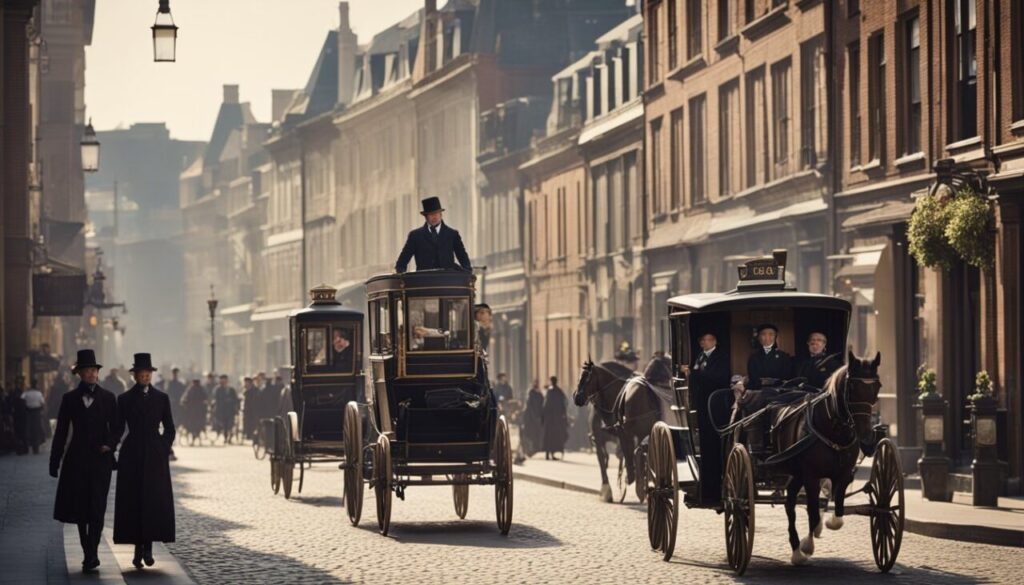
However, that was not the case in reality. Two hundred or even a hundred years ago people had really challenging lives with many struggles like lack of money, food, and proper medicinal care.
People worked hard, especially those who weren’t rich. Families were led by the father, and women mainly took care of the home and kids. There were rich, middle-class, and poor people, and it was hard to move up.
However, the 19th century also brought many advancements that positively impacted society. In the 1800s medicine progressed with many new inventions like anesthesia, antiseptics, and germ theory.
Additionally, industrialization in the 19th century transformed society by creating new urban centers and job opportunities, leading to a significant migration from rural to urban areas.
While it brought economic growth, it also led to tough working conditions, including long hours and low wages, especially for the working class.
Overall, the 19th century was a time of big changes with good and bad sides. It saw lots of new inventions and economic growth, but also made life tough for many workers.
If we were to name 1 most positive side of the 19th century and 1 most negative, those would be:
- Positive: at the start of the 19th Century, people’s way of life wasn’t much different from how it had been 200 or even 300 years earlier. However, by 1899, their way of life had changed considerably, resembling ours today.
- Negative: Horrible working conditions for most workers that continued into the 20th century.




















